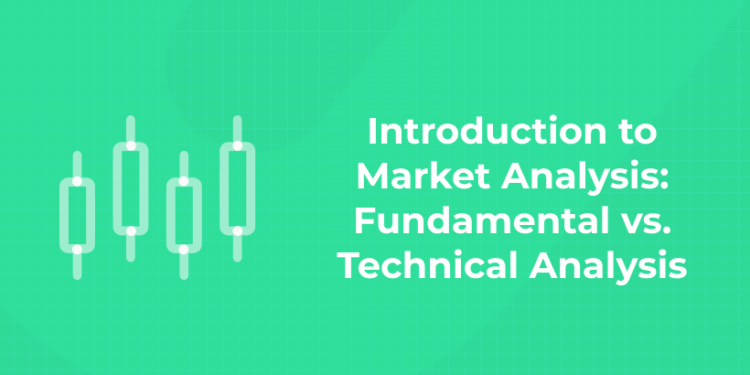Table of Contents
Approaching markets and analyzing the growth of the market are the two essential criteria that investors and traders should pay keen attention to. The market is prone to risks and changes. Market analysis can be challenging. While you are investing your time in market analysis make sure to approach it with extra care. There are two kinds of market analysis, namely, fundamental and technical analysis. Get introduced to market analysis and its significance in various fields. Understand the types – fundamental and technical analysis , and how they help evaluate assets like stocks or currencies. Learn how market trends, economic indicators, and price patterns are analyzed to make informed decisions, whether in trading or business strategies.
Market Analysis: An Overview
The two schools of analysis to approach the markets are fundamental and technical analysis. Both of them are at opposite ends of the horizon. To understand the stock prices and the risks associated with them, traders and investors should use research and forecast methods to deal with the markets. Any strategies that you adopt in the investment are crucial for future market possibilities. Both analysis have advantages and disadvantages.
Master stock trading with us. Enroll now for a free demo!
Fundamental analysis
1: What is a stock?
Fundamental analysis is the analysis that attempts to measure the value of the market by finding out the intrinsic essence of the stocks. It studies everything in the market based on the overall industry value and economy. It shows the management of the companies and the strength of finance under various circumstances. The fundamental analysis can be done by considering the assets, expenses and liabilities of a company.
Technical Analysis
Technical analysis is different from fundamental analysis in all its senses. The statically strengths will be identified by the investors and traders in search of better opportunities. The stock price and volume value are considered to understand the risk elements in the industry. The stock elements are turned into price values and the extra need for the analysis of those factors is not necessary. Technical analysis is an analysis that pays zero attention to the intrinsic value of the security.
The technical analysis uses the stock charts to estimate the current trends and existing patterns in the stocks and estimate the future growth or depletion of the market value.
The stock trends can be identified based on the average daily price with the aid of the simple moving averages. The longer duration and shorter duration movement of the signals related to the selling and buying of the stocks is crucial. Price support and resistance are the two key areas that define the market. Analysts may look into the support and resistance to understand the pulse of the market. Usually, buying happens at support and selling takes place at resistance.
Moving average Divergence
Moving average divergence (MACD), Chaikin Money Flow and Stochastics are the famous momentum-based indicators. The buy and sell signals are based on different criteria and have unique value and property. These indicators are frequently used in trendless markets.
Start investing like a pro. Enroll in our Stock Market course!
Investment vs Trading
Both the technical and fundamental analyses are different in their overall goals. Fundamental analysis usually analyses the long-term investment scenarios in a business. The time frame that the fundamental analysis makes use of is the long-term one. The data which is generated for the analysis is much slower than the indicators used by the technical analysts.
The technical and fundamental analysis are often considered as existing in different poles. Even though they are analysing the securities and the market value, the goals are different. However, some investors have achieved their desired success with the help of the combination of both techniques. The undervalued stocks are analysed and technical data is used as a powerful indicator to find out the changes in the market. Some of the investors make use of technical analysis to find the variations in the market and improve their trade opportunities. Many of the investors have not yet received the mingling of both the fundamental and technical analysis to study the market. Understanding both techniques can enrich you.
Entri App will give you proper guidance in the stock market. The stock market is prone to changes and risks. Understanding the stock market can do good for people who are interested in investing and acquiring the benefits within a limited period from the stock market.
Start learning share trading today! Get Free Demo Here!
Fundamental vs. Technical Analysis: FAQs
- Why should we analyze the market before starting to invest?
The two schools of analysis to approach the markets are fundamental and technical analysis. Both of them are at opposite ends of the horizon. To understand the stock prices and the risks associated with them, traders and investors should use research and forecast methods to deal with the markets.
- What is fundamental market analysis?
Fundamental analysis is the analysis that attempts to measure the value of the market by finding out the intrinsic essence of the stocks. It studies everything in the market based on the overall industry value and economy.
- What is technical analysis?
Technical analysis is different from fundamental analysis in all its senses. The statical strengths will be identified by the investors and traders in search of better opportunities. The stock price and volume value are considered to understand the risk elements in the industry.
- What is the difference between fundamental and technical analysis?
There are two kinds of market analysis, namely, fundamental and technical analysis. The technical analysis uses the stock charts to estimate the current trends and existing patterns in the stocks and estimate the future growth or depletion of the market value. The stock trends can be identified based on the average daily price with the aid of the simple moving averages. The fundamental analysis can be done by considering the assets, expenses and liabilities of a company.











